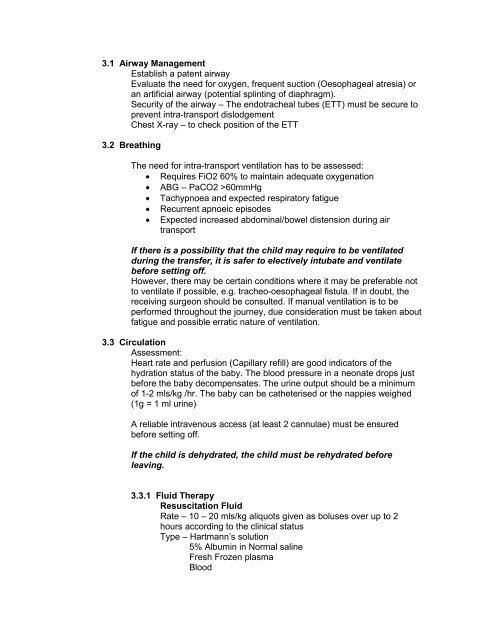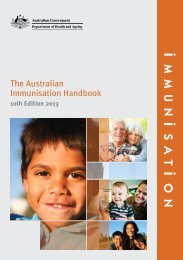Contents Chapter Topic Page Neonatology Respiratory Cardiology
Contents Chapter Topic Page Neonatology Respiratory Cardiology
Contents Chapter Topic Page Neonatology Respiratory Cardiology
Create successful ePaper yourself
Turn your PDF publications into a flip-book with our unique Google optimized e-Paper software.
3.1 Airway Management<br />
Establish a patent airway<br />
Evaluate the need for oxygen, frequent suction (Oesophageal atresia) or<br />
an artificial airway (potential splinting of diaphragm).<br />
Security of the airway – The endotracheal tubes (ETT) must be secure to<br />
prevent intra-transport dislodgement<br />
Chest X-ray – to check position of the ETT<br />
3.2 Breathing<br />
The need for intra-transport ventilation has to be assessed:<br />
• Requires FiO2 60% to maintain adequate oxygenation<br />
• ABG – PaCO2 >60mmHg<br />
• Tachypnoea and expected respiratory fatigue<br />
• Recurrent apnoeic episodes<br />
• Expected increased abdominal/bowel distension during air<br />
transport<br />
If there is a possibility that the child may require to be ventilated<br />
during the transfer, it is safer to electively intubate and ventilate<br />
before setting off.<br />
However, there may be certain conditions where it may be preferable not<br />
to ventilate if possible, e.g. tracheo-oesophageal fistula. If in doubt, the<br />
receiving surgeon should be consulted. If manual ventilation is to be<br />
performed throughout the journey, due consideration must be taken about<br />
fatigue and possible erratic nature of ventilation.<br />
3.3 Circulation<br />
Assessment:<br />
Heart rate and perfusion (Capillary refill) are good indicators of the<br />
hydration status of the baby. The blood pressure in a neonate drops just<br />
before the baby decompensates. The urine output should be a minimum<br />
of 1-2 mls/kg /hr. The baby can be catheterised or the nappies weighed<br />
(1g = 1 ml urine)<br />
A reliable intravenous access (at least 2 cannulae) must be ensured<br />
before setting off.<br />
If the child is dehydrated, the child must be rehydrated before<br />
leaving.<br />
3.3.1 Fluid Therapy<br />
Resuscitation Fluid<br />
Rate – 10 – 20 mls/kg aliquots given as boluses over up to 2<br />
hours according to the clinical status<br />
Type – Hartmann’s solution<br />
5% Albumin in Normal saline<br />
Fresh Frozen plasma<br />
Blood
















